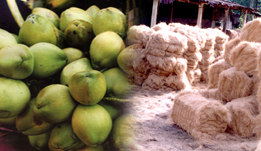Business Overview (Introduction)
 The Coir Industry in India has a strong position in the export orientation since the early days, when trade was dominated by European companies. At the beginning of the independence of the local trade in the hands came a turning point in the history of the coconut industry in India. Structure of production and relations have changed sign ficantly.The pattern of exports and product mix has changed.The level of fiber and yarn exporter, India is an exporter of goods with added value.
The Coir Industry in India has a strong position in the export orientation since the early days, when trade was dominated by European companies. At the beginning of the independence of the local trade in the hands came a turning point in the history of the coconut industry in India. Structure of production and relations have changed sign ficantly.The pattern of exports and product mix has changed.The level of fiber and yarn exporter, India is an exporter of goods with added value.
This in turn led to a significant change in total volume and value of exports. During the year 1950 the average export volume dropped to 73,200 tons per year. In 1960 the export volume decreased to 62 300 tonnes per year. It's back to 45 700 tonnes per year continue in the 1070s and 26 700 tonnes in 1980. But in light of the value that the regeneration of all time. From an average annual export realization of Rs.80 million in 1950 was Rs.120 million in 1960, one million Rs.210 Rs.300 million in 1970 and 1980. Until the mid-90s was Rs.1, € 710 million in sales to Rs. 3,400 million in 2003.
The first year is mainly for the export of coir yarn to European countries for agricultural purposes and legumes and hops as a raw material - material for the industrial units involved in the production of coconut. Easy access to plastic at competitive prices and rising labor costs in Europe coconut industry forced to close or reduce production, leaving a gap in the global markets. But India is not effective to use this option, the course for the plastic on the scene to establish beyond reasonable doubt. The replacement of a natural floor segments with synthetic irreversible damage to the Indian industry and trade of coconut, the side effects still exist.
The first year is mainly for the export of coir yarn to European countries for agricultural purposes and legumes and hops as a raw material - material for the industrial units involved in the production of coconut. Easy access to plastic at competitive prices and rising labor costs in Europe coconut industry forced to close or reduce production, leaving a gap in the global markets. But India is not effective to use this option, the course for the plastic on the scene to establish beyond reasonable doubt. The replacement of a natural floor segments with synthetic irreversible damage to the Indian industry and trade of coconut, the side effects still exist.